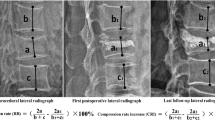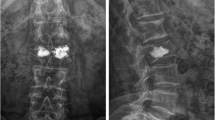Abstract
The purpose of this study was to analyse the number and types of secondary fractures, and to investigate the impact of intradiscal cement leaks for adjacent vertebral fractures. Patients with osteoporotic vertebral fractures were treated with vertebroplasty. Results were documented and prospectively followed by means of computed tomography (CT) and magnetic resonance imaging. The frequency and the types of cement leakages were analysed from multiplanar CT images and secondary fractures were characterised as follows: (1) adjacent fracture in the immediate vicinity of an augmented vertebra; (2) sandwich fracture, fracture of an untreated vertebra between two vertebrae that had been previously augmented, and (3) distant fractures not in the vicinity of augmented vertebrae. A total of 385 osteoporotic vertebral fractures were treated in 191 patients (61 men, 130 women, age 70.7 ± 9.7 years). The overall rate of cement leaks was 55.6%, including all leaks detectable by CT. Intradiscal leaks through the upper, the lower, and both endplates occurred in 18.2%, 6.8%, and 2.6%, respectively. In 39 patients (20.4%), a total of 72 secondary fractures occurred: 30 adjacent fractures in 23 patients (12.0%) with a time to fracture of 2 months [median; 1.0/4.0 months, first/third quartile (Q1/Q3)]; 11 secondary sandwich fractures in 11 patients (5.8%) after 1.5 months (median; 0.25/7.5 months, Q1/Q3); and 31 distant fractures in 20 patients (10.5%) after 5 months (median; 2.0/8.0 months, Q1/Q3). Ten of 30 adjacent fractures occurred in the presence of pre-existing intradiscal cement leaks and 20 where there was no leakage. Six of 11 sandwich fractures occurred in the presence of intradiscal leaks (five leaks in both adjacent disc spaces, one leak in the lower disc space) and five where there was no leakage. The rate of secondary adjacent and non-adjacent fractures is quite similar and there is no specific impact of intradiscal leakages on the occurrence of adjacent secondary fractures. Adjacent fractures occur sooner than distant secondary fractures. Sandwich fractures are associated with specific biomechanical conditions, with a 37.9% fracture rate in sandwich constellations.


Similar content being viewed by others
References
Lindsay R, Silverman SL, Cooper C, Hanley DA, Barton I, Broy SB, Licata A, Benhamou L, Geusens P, Flowers K, Stracke H, Seeman E (2001) Risk of new vertebral fracture in the year following a vertebral fracture. JAMA 285:320–323
Kado DM, Browner WS, Palermo L, Nevitt MC, Genant HK, Cummings SR (1999) Vertebral fractures and mortality in older women. Arch Intern Med 159:1215–1220
Debussche-Depriester C, Deramond H, Fardellone P (1991) Percutaneous vertebroplasty with acrylic cement in the treatment of osteoporotic vertebral crush fracture syndrome. Neuroradiology 33(Suppl):149–152
Deramond H, Depriester C, Galibert P, Le Gars D (1998) Percutaneous vertebroplasty with polymethylmethacrylate: technique, indications, and results. Radiol Clin North Am 36:533–546
Gangi A, Dietmann JL, Guth S, Steib JP, Roy C (1999) Computed tomography (CT) and fluoroscopy-guided vertebroplasty: results and complications in 187 patients. Semin Intervent Radiol 16:137–142
Alvarez L, Alcaraz M, Perez-Higueras A, Granzio JJ, deMiguel I, Rossi RE, Quinones D (2006) Percutaneous vertebroplasty: functional improvement in patients with osteoporotic compression fractures. Spine 31:1113–1118
Komemushi A, Tanigawa N, Kariya S, Kojima H, Shomura Y, Komemushi S, Sawada S (2006) Percutaneous vertebroplasty for osteoporotic compression fracture: multivariate study of predictors of new vertebral body fracture. Cardiovasc Interv Radiol 29:580–585
Tanigawa N, Komemushi A, Kariya S, Kojima H, Shomura Y, Sawada S (2006) Radiological follow-up of new compression fractures following percutaneous vertebroplasty. Cardiovasc Interv Radiol 29:92–96
Berlemann U, Ferguson SJ, Nolte L-P, Heini PF (2002) Adjacent vertebral failure after vertebroplasty. J Bone Joint Surg (Br) 84-B:748–752
Singh AK, Pilgram TK, Gilula L (2006) Osteoporotic compression fractures: outcomes after single-versus multiple-level percutaneous vertebroplasty. Radiology 238:211–220
Diamond TH, Bryant C, Browne L, Clark WA (2006) Clinical outcomes after actue osteoporotic vertebral fractures: a 2-year non-randomised trial comparing percutaneous vertebroplasty with conservative therapy. Med J Aust 184:113–117
Hochmuth K, Proschek D, Schwarz W et al (2006) Percutaneous vertebroplasty in the therapy of osteoporotic vertebral compression fractures: a critical review. Eur Radiol 16:998–1004
Guglielmi G, Andreula C, Muto M et al (2005) Percutaneous vertebroplasty: indications, contraindications, technique, and complications. Acta Radiol 46:256–268
Mirovsky Y, Anekstein Y, Shalmon E, Blankstein A, Peer A (2006) Intradiscal cement leak following percutaneous vertebroplasty. Spine 31:1120–1124
Mirovsky Y, Anekstein Y, Ahalmon E, Peer A (2005) Vacuum clefts of the vertebral bodies. AJNR Am J Neuroradiol 26:1634–1640
Oka M, Matsusako M, Kobayashi N, Uemura A, Numaguchi Y (2005) Intravertebral cleft sign on fat-suppressed contrast-enhanced MR. Correlation with cement distribution pattern on percutaneous vertebroplasty. Acad Radiol 12:992–999
Krauss M, Hirschfelder H, Tomandl B, Lichti G, Bar I (2006) Kyphosis reduction and the rate of cement leaks after vertebroplasty of intravertebral clefts. Eur Radiol 16:1015–1021
Kaufmann TJ, Trout AT, Kallmes DF (2006) The effects of cement volume on clinical outcomes of percutaneous vertebroplasty. AJNR Am J Neuroradiol 27:1933–1937
Pflugmacher R, Kandziora F, Schröder R, Schleicher P, Scholz M, Schnake K, Haas N, Khodadadyan-Klostermann C (2005) Vertebroplasty and kyphoplasty in osteoporotic fractures of vertebral bodies—a prospective 1 year follow-up analysis. Rofo 177:1670–1676
Mousavi P, Roth S, Finkelstein J, Cheung G, Whyne C (2003) Volumetric quantification of cement leakage following percutaneous vertebroplasty in metastatic and osteoporotic vertebrae. J Neurosurg 99:56–59
Schmidt R, Cakir B, Mattes T, Wegener M, Puhl W, Richter M (2005) Cement leakage during vertebroplasty: an underestimated problem? Eur Spine 14:466–473
Weber CH, Krötz M, Hoffmann R-T, Euler E, Heining S, Pfeiffer K-J, Reiser M, Linsenmaier U (2006) CT-guided vertebroplasty and kyphoplasty: comparing technical success rate and complication in 101 cases. Fortschr Röntgenstr 178:610–617
Vallejo R, Benyamin R, Floyd B, Casto JM, Joseph NJ, Mekhail N (2006) Percutaneous cement injection into a created cavity for the treatment of vertebral body fracture: preliminary results of a new vertebroplasty technique. Clin J Pain 22:182–189
Schulte BU, Brucher D, Trompeter M, Remy C, Reimer P (2006) Balloon-assisted percutaneous vertebroplasty in patients with osteoporotic vertebral body compression fractures—first results. Rofo 178:207–213
Bhatia C, Barzilay Y, Krishna M, Friesem T, Pollock R (2006) Cement leakage in percutaneous vertebroplasty: effect of preinjection gelfoam embolization. Spine 31:915–919
Baroud G, Bohner M (2006) Biomechanical impact of vertebroplasty. Postoperative beiomechanics of vertebroplasty. Jt Bone Spine 73:144–150
Kayanja MM, Schlenk R, Togawa D, Ferrara L, Lieberman I (2006) The biomechanics of 1, 2, and 3 levels of vertebral augmentation with polymethylmethacrylate in multilevel spinal segments. Spine 7:769–774
Syed MI, Patel NA, Jan S, Harron MS, Morar K, Skaikh A (2005) Intrasdiskal extravasation with low-volume cement filling in percutaneous vertebroplasty. AJNR Am J Neuroradiol 26:2397–2401
Trout AT, Kallmes DF, Kaufmann TJ (2006) New fractures after vertberoplasty: adjacent fractures occur significantly sooner. AJNR Am J Neuroradiol 27:217–223
Author information
Authors and Affiliations
Corresponding author
Rights and permissions
About this article
Cite this article
Pitton, M.B., Herber, S., Bletz, C. et al. CT-guided vertebroplasty in osteoprotic vertebral fractures: incidence of secondary fractures and impact of intradiscal cement leakages during follow-up. Eur Radiol 18, 43–50 (2008). https://doi.org/10.1007/s00330-007-0694-y
Received:
Revised:
Accepted:
Published:
Issue Date:
DOI: https://doi.org/10.1007/s00330-007-0694-y




